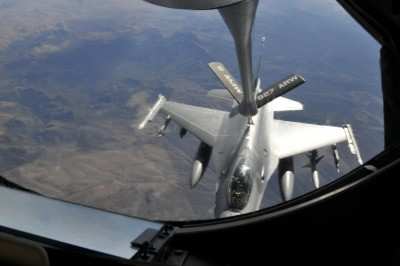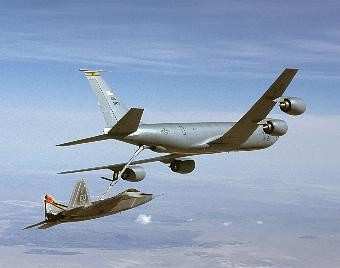Air Force Taking A Page From The Airline's Manual
Members of the Air Force's Fuel Efficiency Office are hosting
the first service-wide Aviation Operations Energy Steering Group
summit at Scott Air Force Base in Illinois, which concludes
Thursday. Representatives from all Air Force major commands were
invited to attend the summit. The event will be the first major
meeting across the MAJCOMs, hosted by members of the AMC FEO, who
plan to discuss ideas and lessons learned with counterparts.

"We've been designated the 'champion' by the folks at
Headquarters Air Force for aviation operations fuel efficiency,"
said Col. Kevin Trayer, AMC FEO deputy director. "We think a lot of
what's being done here (at AMC) can translate into other
commands."
Since 2008, AMC has saved $83 million in aviation fuel costs
through fuel conservation efforts, said Col. Bobby Fowler, FEO
director. The FEO was chartered in such a way that mobility air
forces could learn from fuel efficiency achievements in the
civilian industry. Reservists who also work as airline pilots, such
as Colonel Trayer, bring valuable insight to the Air Force fuel
conservation effort. "We've flown in an environment where energy is
a consideration in everything we've done, because it directly
affects the bottom line," Colonel Trayer said. "So, to transition
that experience and put it inside the paradigm of military aviation
(has) been a challenge, but it's also shown great benefit."
One of the lessons learned from the commercial industry is that
tracking fuel efficiency data is vital. This tracking is critical
to any fuel efficiency program and will be needed in most Air Force
major commands. The Web-based fuel tracker they implemented was
among the first AMC FEO initiatives. During a mission,
aircrew members gather critical information for the database. The
tracker serves as a major source of the necessary data for AMC's
program, and is a stop gap manual effort while AMC experts work to
enhance the Aircraft Communication and Reporting System, which will
provide the required data automatically.

While AMC officials understand manual reporting is not the
desired end state for data collection, it does serve the purpose of
focusing the crews on their use of aviation fuel, which assists the
command in attaining the culture change necessary for long-term
success. Another AMC FEO initiative that might resonate with other
major commands is working with Air Force Materiel Command to pursue
new technologies, such as upgraded or new engines for older
airframes, and staying on top of Federal Aviation Administration
initiatives. One of the FAA's new mantras as they bring on new
technologies is "better equipped is better served," Colonel Fowler
said.
"(Airline officials) are going out and looking at the things FAA
is requiring for future aviation to bring on what's now called
NextGen, where I can truly navigate on my own to get from point A
to point B without the current airspace limitations, so I can pick
the most fuel efficient route to get there," he said. "NextGen is
both an opportunity and a possible pitfall for the MAF because
those who do not equip their airplanes end up with what's left from
an airspace perspective," said Lt. Col. Eric Lepchenske, a fuel
efficiency officer who is also a reservist and airline pilot.
"If we delay implementation of these important modifications to
our fleet, the possible savings to be gained from NextGen become a
bill to pay as we are relegated to less efficient altitudes and
flight routings," Colonel Lepchenske said.
"The FEO is conducting a business case analysis to determine
what the cost to equip mobility aircraft to fly in that airspace
will be, versus the cost of being relegated to flying undesirable
flight profiles," Colonel Fowler said. The office staff also is
engaging with FAA officials on the future concept of optimum
profile descents.
"Traditionally, at a busy airport like Charleston Air Force
Base, S.C., airplanes arrive from any direction and a controller on
the ground will sequence them into a kind of box and put them in
line," said Colonel Lepchenske. "As more airplanes show up, the
line gets longer, and delays occur. What they've done now is helped
automate some of that by using a computer to predict when some of
those guys are going to hit certain points in the airspace," he
said. "Then there's one descent profile to the active runway that
everyone will use."

Regardless of the economic opportunities of fuel efficiency, one
common goal will trump discussion of fuel savings during the
summit. While the airline industry's bottom line is profit, the Air
Force's bottom line is how to best serve the warfighter. It's a
mission for which mobility Airmen, among others, were recently
commended by the chairman of the Joint Chiefs of Staff in a letter.
"You are the muscle that moves, sustains, builds, and heals our
nation's most precious resource: the men and women of our Armed
Forces," the letter states.
"We will do whatever it takes to support the warfighter, no
matter what," Colonel Fowler said. "It is about getting the
(service member) what he needs in the most effective manner
possible."
"I've been on the (operations) floor ... when there is a
life-threatening injury, just one individual, over in theater who
needs to get to Brooke (Army Medical Center in San Antonio),"
Colonel Trayer said. "And literally, we will drop everything to
make that happen. We get the job done, and that will never change,"
he said.
 ANN's Daily Aero-Linx (04.16.24)
ANN's Daily Aero-Linx (04.16.24) Aero-News: Quote of the Day (04.16.24)
Aero-News: Quote of the Day (04.16.24) Airborne 04.10.24: SnF24!, A50 Heritage Reveal, HeliCycle!, Montaer MC-01
Airborne 04.10.24: SnF24!, A50 Heritage Reveal, HeliCycle!, Montaer MC-01 Airborne 04.12.24: SnF24!, G100UL Is Here, Holy Micro, Plane Tags
Airborne 04.12.24: SnF24!, G100UL Is Here, Holy Micro, Plane Tags Airborne-Flight Training 04.17.24: Feds Need Controllers, Spirit Delay, Redbird
Airborne-Flight Training 04.17.24: Feds Need Controllers, Spirit Delay, Redbird





